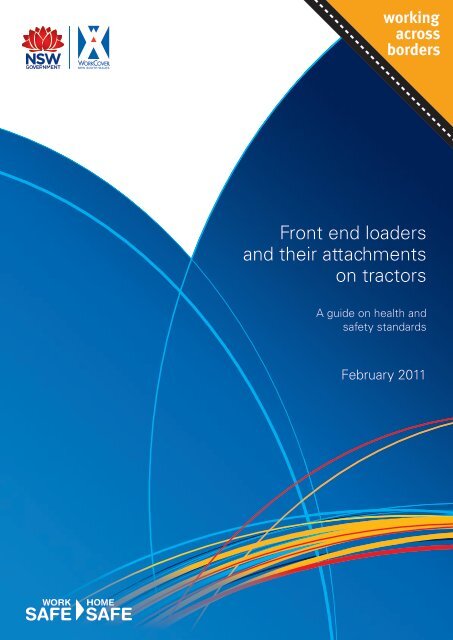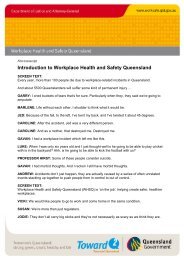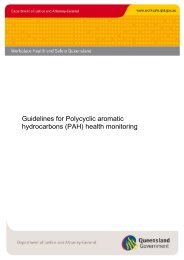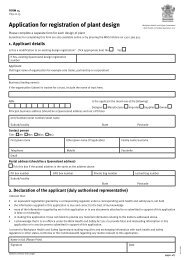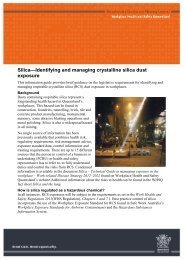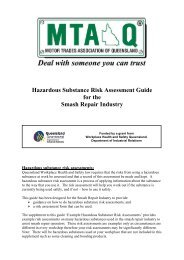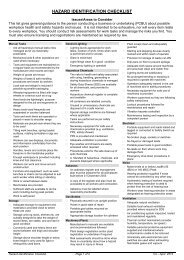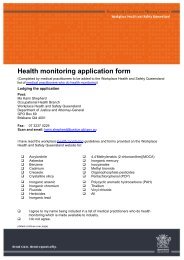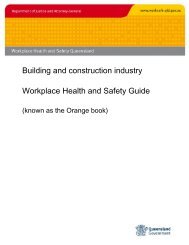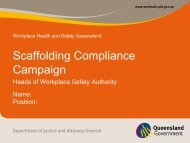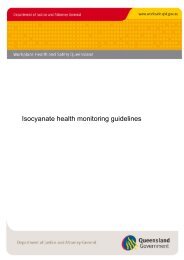Front end loaders and their attachments on tractors: A guide on ...
Front end loaders and their attachments on tractors: A guide on ...
Front end loaders and their attachments on tractors: A guide on ...
- No tags were found...
You also want an ePaper? Increase the reach of your titles
YUMPU automatically turns print PDFs into web optimized ePapers that Google loves.
1. INTRODUCTIONThe Industry Soluti<strong>on</strong>s Program is a research <str<strong>on</strong>g>and</str<strong>on</strong>g> development initiative undertaken byWorkCover NSW, which has worked with industry to devise practical soluti<strong>on</strong>s to problematicissues in an industry. It recognises the need for assistance in some industry sectors toovercome particular difficulties or challenges in order to improve workplace safety.Soluti<strong>on</strong>s to safety issues are developed in partnership with industry <str<strong>on</strong>g>and</str<strong>on</strong>g> released forindustry-wide implementati<strong>on</strong>. Within 12 m<strong>on</strong>ths, an evaluati<strong>on</strong> is c<strong>on</strong>ducted to determinethe effectiveness <str<strong>on</strong>g>and</str<strong>on</strong>g> practicality of the soluti<strong>on</strong>s. If necessary, further refinements,including additi<strong>on</strong>al soluti<strong>on</strong>s, are included after the evaluati<strong>on</strong>.WorkCover is aiming to harm<strong>on</strong>ise industry soluti<strong>on</strong>s in c<strong>on</strong>juncti<strong>on</strong> with other occupati<strong>on</strong>alhealth <str<strong>on</strong>g>and</str<strong>on</strong>g> safety (OHS) jurisdicti<strong>on</strong>s to develop a comm<strong>on</strong> approach to c<strong>on</strong>trol hazards.The Industry Soluti<strong>on</strong>s Program identified that fr<strong>on</strong>t <str<strong>on</strong>g>end</str<strong>on</strong>g> loader <str<strong>on</strong>g>attachments</str<strong>on</strong>g> designed for use<strong>on</strong> a tractor can be hazardous to operate <str<strong>on</strong>g>and</str<strong>on</strong>g> that there is currently no practical guidanceavailable in Australia for <str<strong>on</strong>g>their</str<strong>on</strong>g> design <str<strong>on</strong>g>and</str<strong>on</strong>g> use – hence this <strong>guide</strong> was developed.C<strong>on</strong>tributors to this <strong>guide</strong> include:• Burder Group Australian• Challenge Implements• Howard Australia• Farmsafe Australia• John Deere• Kentan Machinery (FIMDA)• Kubota Tractor Australia• Motor Traders Associati<strong>on</strong> NSW• Nowra Truck <str<strong>on</strong>g>and</str<strong>on</strong>g> Tractor (FIMDA)• NSW Farmers Industrial Associati<strong>on</strong>• Online Safety Systems• Tractor <str<strong>on</strong>g>and</str<strong>on</strong>g> Machinery Associati<strong>on</strong> of Australia• Workplace Health <str<strong>on</strong>g>and</str<strong>on</strong>g> Safety Queensl<str<strong>on</strong>g>and</str<strong>on</strong>g>, Department of Justice <str<strong>on</strong>g>and</str<strong>on</strong>g> Attorney-General• WorkSafe Victoria• WorkSafe Western Australia• Workplace St<str<strong>on</strong>g>and</str<strong>on</strong>g>ards Tasmania, Department of Justice.This <strong>guide</strong> provides practical guidance for designers, manufacturers, suppliers <str<strong>on</strong>g>and</str<strong>on</strong>g> usersof fr<strong>on</strong>t <str<strong>on</strong>g>end</str<strong>on</strong>g> loader <str<strong>on</strong>g>attachments</str<strong>on</strong>g> <strong>on</strong> <strong>tractors</strong>. OHS legislati<strong>on</strong> requires the c<strong>on</strong>trol of risk tohealth <str<strong>on</strong>g>and</str<strong>on</strong>g> safety, <str<strong>on</strong>g>and</str<strong>on</strong>g> following this <strong>guide</strong> is a means to achieve such compliance.2
4. DESIGNOHS legislati<strong>on</strong> places obligati<strong>on</strong>s <strong>on</strong> designers to identify hazards <str<strong>on</strong>g>and</str<strong>on</strong>g> c<strong>on</strong>trol the risksassociated with the design, manufacture, supply <str<strong>on</strong>g>and</str<strong>on</strong>g> use of plant. The designer must, wherereas<strong>on</strong>ably practicable, design-out any risks associated with the use of the FEL <str<strong>on</strong>g>and</str<strong>on</strong>g>/or its<str<strong>on</strong>g>attachments</str<strong>on</strong>g>. Where the risks cannot be designed-out, a means to c<strong>on</strong>trol the risks mustbe provided.The designer must provide informati<strong>on</strong> to the manufacturer, which includes advice <strong>on</strong>:• results of testing <str<strong>on</strong>g>and</str<strong>on</strong>g> examinati<strong>on</strong> c<strong>on</strong>ducted during the design phase• purpose for which the FEL <str<strong>on</strong>g>and</str<strong>on</strong>g> its <str<strong>on</strong>g>attachments</str<strong>on</strong>g> are designed• limitati<strong>on</strong>s <strong>on</strong> its use• testing <str<strong>on</strong>g>and</str<strong>on</strong>g> inspecti<strong>on</strong>s to be carried out <strong>on</strong> the FEL <str<strong>on</strong>g>and</str<strong>on</strong>g> its <str<strong>on</strong>g>attachments</str<strong>on</strong>g>• installati<strong>on</strong> <str<strong>on</strong>g>and</str<strong>on</strong>g> commissi<strong>on</strong>ing, operati<strong>on</strong>, maintenance, transport, storage <str<strong>on</strong>g>and</str<strong>on</strong>g>dismantling• systems of work necessary for the safe use of the FEL <str<strong>on</strong>g>and</str<strong>on</strong>g> its <str<strong>on</strong>g>attachments</str<strong>on</strong>g>• knowledge, training <str<strong>on</strong>g>and</str<strong>on</strong>g> skills necessary for undertaking inspecti<strong>on</strong> <str<strong>on</strong>g>and</str<strong>on</strong>g> testing of theFEL <str<strong>on</strong>g>and</str<strong>on</strong>g> its <str<strong>on</strong>g>attachments</str<strong>on</strong>g>.The following secti<strong>on</strong>s provide advice <strong>on</strong> specific hazards that are associated with FELs <str<strong>on</strong>g>and</str<strong>on</strong>g><str<strong>on</strong>g>their</str<strong>on</strong>g> <str<strong>on</strong>g>attachments</str<strong>on</strong>g>, <str<strong>on</strong>g>and</str<strong>on</strong>g> should be addressed in the design.4.1 ROLLBACKRollback of the load <strong>on</strong>to the operator is a cause of serious incidents when h<str<strong>on</strong>g>and</str<strong>on</strong>g>lingmaterials. Therefore, it is essential that all FELs incorporate a rollback eliminati<strong>on</strong>system.The designer must eliminate the possibility of rollback when the tractor, FEL <str<strong>on</strong>g>and</str<strong>on</strong>g>attachment combinati<strong>on</strong> is used for its int<str<strong>on</strong>g>end</str<strong>on</strong>g>ed purpose <strong>on</strong> a level surface. They shouldalso provide informati<strong>on</strong> <strong>on</strong> how to c<strong>on</strong>trol rollback <strong>on</strong> sloping ground, including the loadlimitati<strong>on</strong>s for manufacturer-approved <str<strong>on</strong>g>attachments</str<strong>on</strong>g>.If the FEL <str<strong>on</strong>g>and</str<strong>on</strong>g> its <str<strong>on</strong>g>attachments</str<strong>on</strong>g> are not from the same designer, the pers<strong>on</strong> putting thetwo together must ensure they are compatible, <str<strong>on</strong>g>and</str<strong>on</strong>g> that rollback is eliminated.Self-leveling systems must be designed so they cannot be overriden to create rollback.Figures 1b <str<strong>on</strong>g>and</str<strong>on</strong>g> 2b illustrate self-leveling as a c<strong>on</strong>trol for rollback.4
✗Figure: 1aThe angle of the earthmoving bucket attachment, relative to the ground, is greatly increased asthe FEL is raised, which allows the load to rollback <strong>on</strong> to the tractor or operator.✓Figure: 1bWith self-leveling anti-rollback device incorporated into the FEL <str<strong>on</strong>g>and</str<strong>on</strong>g> its <str<strong>on</strong>g>attachments</str<strong>on</strong>g>, the angleremains the same <str<strong>on</strong>g>and</str<strong>on</strong>g> ensures the risk of rollback is eliminated when operated correctly.5
4.2 HYDRAULIC SYSTEMSNew hydraulic hoses must have a safety factor of 4:1 – ie the minimum burst pressure ofthe hose must be four times greater than to the maximum working pressure. All hydraulichoses must be in good c<strong>on</strong>diti<strong>on</strong> <str<strong>on</strong>g>and</str<strong>on</strong>g> be serviceable.Operator c<strong>on</strong>trols <str<strong>on</strong>g>and</str<strong>on</strong>g> hoses should be located, <str<strong>on</strong>g>and</str<strong>on</strong>g>/or guarded if reas<strong>on</strong>ably practicable,to prevent oil injecti<strong>on</strong>, or burn injuries caused by c<strong>on</strong>tact with oil over 50 degrees celsius,in the event of a hose or coupling failure. Guarding can take the form of a hose sock orrigid guard.It is not always reas<strong>on</strong>ably practical to guard quick-disc<strong>on</strong>nect couplers.4.3 STABILITY AND RATED OPERATING LOAD (ROL)The additi<strong>on</strong> of the FEL attachment to a tractor will adversely affect its stability <str<strong>on</strong>g>and</str<strong>on</strong>g>axle loadings. Counterweights or ballasting may be required to improve stability.The ROL of the FEL <str<strong>on</strong>g>and</str<strong>on</strong>g> its <str<strong>on</strong>g>attachments</str<strong>on</strong>g>, <str<strong>on</strong>g>and</str<strong>on</strong>g> associated ballast requirements, must bedetermined in accordance with:• EN 12525 – Agricultural machinery – <str<strong>on</strong>g>Fr<strong>on</strong>t</str<strong>on</strong>g> <str<strong>on</strong>g>loaders</str<strong>on</strong>g> – Safety• Code of practice for manufacture <str<strong>on</strong>g>and</str<strong>on</strong>g> supply of fr<strong>on</strong>t <str<strong>on</strong>g>end</str<strong>on</strong>g> <str<strong>on</strong>g>loaders</str<strong>on</strong>g> for use <strong>on</strong>agricultural <strong>tractors</strong> in Australia (Tractor Machinery Associati<strong>on</strong> of Australia)• ASAE EP562 – Procedure for determining recomm<str<strong>on</strong>g>end</str<strong>on</strong>g>ed ballast <str<strong>on</strong>g>and</str<strong>on</strong>g> minimum rearwheel tread settings for agricultural <strong>tractors</strong> with agricultural fr<strong>on</strong>t <str<strong>on</strong>g>loaders</str<strong>on</strong>g>.The designer must also ensure that the tractor specificati<strong>on</strong>s are not exceeded, whetherthe attachment is loaded or empty. Therefore, specificati<strong>on</strong>s must not be exceeded for:• rear axle loads• fr<strong>on</strong>t axle loads• allowable loadings for attachment points• tyre ratings• total allowable tractor mass.4.4 SECURITY OF LOADThe FEL <str<strong>on</strong>g>and</str<strong>on</strong>g> its <str<strong>on</strong>g>attachments</str<strong>on</strong>g> should be designed to retain the load, when usedaccording to the designer’s limitati<strong>on</strong>s.4.5 CONTROLSOperating c<strong>on</strong>trols of the FEL <str<strong>on</strong>g>and</str<strong>on</strong>g> its <str<strong>on</strong>g>attachments</str<strong>on</strong>g> should be of the hold-to-run (iedeadman) type, except for a float positi<strong>on</strong> <strong>on</strong> the FEL lowering c<strong>on</strong>trol, which can beretained in positi<strong>on</strong>.All c<strong>on</strong>trols for the FEL <str<strong>on</strong>g>and</str<strong>on</strong>g> its <str<strong>on</strong>g>attachments</str<strong>on</strong>g> must be clearly <str<strong>on</strong>g>and</str<strong>on</strong>g> permanently identified(wording must be in English) – see figure 3.C<strong>on</strong>trols should not result in any movement that is counter intuitive to the directi<strong>on</strong> ofc<strong>on</strong>trol movement. The directi<strong>on</strong> of the raise/lower lever or joystick c<strong>on</strong>trols must followthe directi<strong>on</strong> of movement of the assigned functi<strong>on</strong> – eg lever forward to lower,lever back to raise.7
Figure 3: Typical operating c<strong>on</strong>trol identificati<strong>on</strong>4.6 CRUSH AND SHEAR HAZARDSShear hazards between the moving arm <str<strong>on</strong>g>and</str<strong>on</strong>g> stati<strong>on</strong>ary structure of the tractor must beidentified <str<strong>on</strong>g>and</str<strong>on</strong>g> eliminated, where practicable. Where a hazard cannot be eliminated,informati<strong>on</strong> <str<strong>on</strong>g>and</str<strong>on</strong>g> instructi<strong>on</strong>s must be provided in the manufacturer’s instructi<strong>on</strong>s thatidentify the potential hazards <str<strong>on</strong>g>and</str<strong>on</strong>g> recomm<str<strong>on</strong>g>end</str<strong>on</strong>g>ed c<strong>on</strong>trols.The FEL should be removable, to allow unobstructed access for tractor maintenance<str<strong>on</strong>g>and</str<strong>on</strong>g> inspecti<strong>on</strong>. It should be stable when disc<strong>on</strong>nected from the tractor.If it is impracticable to disc<strong>on</strong>nect the FEL, such as in field service, a safe system ofwork must prevent inadvertent lowering of the raised lift arms when there is hydraulicpressure loss of the FEL. A mechanical or hydraulic safety device must be provided aspart of the design. Where a mechanical safety device is provided, it must be located <strong>on</strong>the FEL or the tractor, <str<strong>on</strong>g>and</str<strong>on</strong>g> readily available for use.Where a hydraulic safety device is provided, there must be no possibility of the raisedarm lowering in the event of a single or multiple hydraulic leak or failure in the system– eg hose failure, ram seal damage, valve leakage.8
• warning not to exceed ROL• year of manufacture (or date of supply*).* These may be stamped by the supplier, or provided <strong>on</strong> a separate decal or plate,so that the FEL can be fitted to different tractor models, as per the manufacturer’sinstructi<strong>on</strong>s.5.2 MANUFACTURER’S INSTRUCTIONSThe manufacturer must provide documented operator instructi<strong>on</strong>s in English. Theseinstructi<strong>on</strong>s must clearly specify all informati<strong>on</strong> outlined in secti<strong>on</strong> 5.1.As a minimum, the instructi<strong>on</strong>s should include informati<strong>on</strong> about:• tractor requirements• FEL <str<strong>on</strong>g>and</str<strong>on</strong>g> attachment capabilities• inspecti<strong>on</strong> <str<strong>on</strong>g>and</str<strong>on</strong>g> maintenance requirements• method to attach <str<strong>on</strong>g>and</str<strong>on</strong>g> detach the FEL <str<strong>on</strong>g>and</str<strong>on</strong>g> its <str<strong>on</strong>g>attachments</str<strong>on</strong>g>• storage• operati<strong>on</strong>.The manufacturer should c<strong>on</strong>sider providing more practical means for communicating<str<strong>on</strong>g>their</str<strong>on</strong>g> instructi<strong>on</strong>s, such as an instructi<strong>on</strong>al DVD or web based informati<strong>on</strong>, in additi<strong>on</strong> tothe documented operator instructi<strong>on</strong>s.6. SUPPLIERS6.1 SUPPLIER’S RESPONSIBILITIESThe supplier includes any<strong>on</strong>e involved in the supply, sale, transfer, lease or hire of plantthat is used in a workplace.OHS legislati<strong>on</strong> places obligati<strong>on</strong>s <strong>on</strong> suppliers to identify hazards <str<strong>on</strong>g>and</str<strong>on</strong>g> c<strong>on</strong>trol therisks associated with the supply <str<strong>on</strong>g>and</str<strong>on</strong>g> use of a FEL <str<strong>on</strong>g>and</str<strong>on</strong>g> its <str<strong>on</strong>g>attachments</str<strong>on</strong>g>. They mustensure that any FEL <str<strong>on</strong>g>and</str<strong>on</strong>g> its <str<strong>on</strong>g>attachments</str<strong>on</strong>g>, manufactured after the commencement ofthis <strong>guide</strong>, c<strong>on</strong>forms to the requirements outlined herein, particularly if imported fromabroad, or from another State or Territory, as the manufacturer may not be aware ofthese requirements – see secti<strong>on</strong>s 5.1 <str<strong>on</strong>g>and</str<strong>on</strong>g> 5.2.Suppliers who:• provide advice <strong>on</strong> the suitability of a FEL• provide a FEL for a known tractor• fit a FEL to a tractor, or• provide a FEL/tractor combinati<strong>on</strong>must ensure that the FEL <str<strong>on</strong>g>and</str<strong>on</strong>g> its <str<strong>on</strong>g>attachments</str<strong>on</strong>g> are compatible with the tractor, <str<strong>on</strong>g>and</str<strong>on</strong>g> anyancillary <str<strong>on</strong>g>attachments</str<strong>on</strong>g> that the purchaser has advised will be used.10
The checklist in app<str<strong>on</strong>g>end</str<strong>on</strong>g>ix B assists the supplier to check whether they are complying withthis <strong>guide</strong>. This <strong>guide</strong> can be used to assist you in complying with those requirements.Note: FELs first manufactured prior to the commencement of this <strong>guide</strong> may not complywith the requirements herein. However, this <strong>guide</strong> should still be used to assist youin meeting the risk c<strong>on</strong>trol obligati<strong>on</strong>s in the OHS legislati<strong>on</strong>. Where compliance withthe requirements in this <strong>guide</strong> is not reas<strong>on</strong>ably practicable other measures should beimplemented to c<strong>on</strong>trol the identified risks.6.2 USED EQUIPMENTRegulatory jurisdicti<strong>on</strong>s have different requirements for the sale <str<strong>on</strong>g>and</str<strong>on</strong>g> transfer of usedplant. Ask your workplace regulator for informati<strong>on</strong> <strong>on</strong> the sale or transfer of used plantin your State or Territory. This <strong>guide</strong> can be used to assist you in complying with thoserequirements.6.3 PROVISION OF INFORMATIONThe manufacturer’s instructi<strong>on</strong>s <str<strong>on</strong>g>and</str<strong>on</strong>g> all other informati<strong>on</strong> relevant to the safe use of theFEL <str<strong>on</strong>g>and</str<strong>on</strong>g> its <str<strong>on</strong>g>attachments</str<strong>on</strong>g> must be provided at the point of supply.Prior to sale, the supplier should obtain informati<strong>on</strong> from the purchaser <str<strong>on</strong>g>and</str<strong>on</strong>g> comparethis with the specificati<strong>on</strong>s provided by the manufacturer, to ensure the FEL <str<strong>on</strong>g>and</str<strong>on</strong>g> its<str<strong>on</strong>g>attachments</str<strong>on</strong>g> are fit for the described purpose (when used according to the manufacturer’sinstructi<strong>on</strong>s). The supplier should get informati<strong>on</strong> about the type of tractor to be used, theloads to be h<str<strong>on</strong>g>and</str<strong>on</strong>g>led, <str<strong>on</strong>g>and</str<strong>on</strong>g> the type of terrain <strong>on</strong> which the FEL will be used.6.4 PRACTICAL SAFETY INFORMATIONThe supplier should establish a means to instruct, at the point of supply, those whopurchase a FEL <str<strong>on</strong>g>and</str<strong>on</strong>g> its attachment <strong>on</strong> its safe use. This may include a DVD, aninstructi<strong>on</strong>al sessi<strong>on</strong>, or an explanati<strong>on</strong> of the manufacturer’s instructi<strong>on</strong>s.6.5 RETENTION OF INSTRUCTIONSThe FELs operating instructi<strong>on</strong>s must be provided at the point of sale <str<strong>on</strong>g>and</str<strong>on</strong>g> a copy mustbe stored in a permanent weatherproof receptacle in the tractor, or <strong>on</strong> the FEL.6.6 MODIFICATIONSAny<strong>on</strong>e who modifies the FEL or its <str<strong>on</strong>g>attachments</str<strong>on</strong>g> assumes the role <str<strong>on</strong>g>and</str<strong>on</strong>g> resp<strong>on</strong>sibilitiesof the designer <str<strong>on</strong>g>and</str<strong>on</strong>g> manufacturer. As a general rule, modificati<strong>on</strong>s should not bed<strong>on</strong>e <str<strong>on</strong>g>and</str<strong>on</strong>g>, if they are, they must be d<strong>on</strong>e by a competent pers<strong>on</strong> <str<strong>on</strong>g>and</str<strong>on</strong>g> based <strong>on</strong> a riskassessment. Before any modificati<strong>on</strong>s are d<strong>on</strong>e, c<strong>on</strong>tact the manufacturer or supplier.When modificati<strong>on</strong>s are carried out, review the safety instructi<strong>on</strong>s <str<strong>on</strong>g>and</str<strong>on</strong>g> revise themwhere necessary.11
7. USE7.1 EMPLOYER/CONTROLLER RESPONSIBILITIESOHS legislati<strong>on</strong> places obligati<strong>on</strong>s <strong>on</strong> the employer, or pers<strong>on</strong> in c<strong>on</strong>trol of the plant,including FELs <str<strong>on</strong>g>and</str<strong>on</strong>g> <str<strong>on</strong>g>their</str<strong>on</strong>g> <str<strong>on</strong>g>attachments</str<strong>on</strong>g>, to identify hazards <str<strong>on</strong>g>and</str<strong>on</strong>g> c<strong>on</strong>trol the risksassociated with <str<strong>on</strong>g>their</str<strong>on</strong>g> use in the workplace.When purchasing a FEL or <str<strong>on</strong>g>attachments</str<strong>on</strong>g>:• ensure the manufacturer’s instructi<strong>on</strong>s are provided at the point of purchase• ensure the FEL <str<strong>on</strong>g>and</str<strong>on</strong>g> the <str<strong>on</strong>g>attachments</str<strong>on</strong>g> c<strong>on</strong>form to this <strong>guide</strong>• discuss your needs with the supplier to ensure the FEL <str<strong>on</strong>g>and</str<strong>on</strong>g> the <str<strong>on</strong>g>attachments</str<strong>on</strong>g> arecompatible with your tractor <str<strong>on</strong>g>and</str<strong>on</strong>g> appropriate for the type of work to be undertaken• seek practical advice <str<strong>on</strong>g>and</str<strong>on</strong>g> instructi<strong>on</strong> from the supplier <strong>on</strong> the use <str<strong>on</strong>g>and</str<strong>on</strong>g> limitati<strong>on</strong>sof the FEL <str<strong>on</strong>g>and</str<strong>on</strong>g> the <str<strong>on</strong>g>attachments</str<strong>on</strong>g>.If you are hiring, leasing or borrowing a FEL or an attachment <strong>on</strong> a temporary basis, getsafe use instructi<strong>on</strong>s from the pers<strong>on</strong> supplying it.7.2 ROLL-OVER PROTECTIVE STRUCTURES (ROPS)ROPS must be manufactured <str<strong>on</strong>g>and</str<strong>on</strong>g> maintained according to AS1636 (series) Tractors– Roll-over protective structures – Criteria <str<strong>on</strong>g>and</str<strong>on</strong>g> tests. A plate or decal c<strong>on</strong>firmingcompliance should be attached to the ROPS’ frame, or inside the tractor cabin.Note: A falling object protective structure (FOPS) is not normally required for agricultural<strong>tractors</strong> but you should assess whether the change of activity relating to the FEL <str<strong>on</strong>g>and</str<strong>on</strong>g> its<str<strong>on</strong>g>attachments</str<strong>on</strong>g> introduces a falling risk. If so, you may need to c<strong>on</strong>sider installing a FOPS.7.3 SECURITY OF LOADFEL <str<strong>on</strong>g>attachments</str<strong>on</strong>g> are designed for specific applicati<strong>on</strong>s <str<strong>on</strong>g>and</str<strong>on</strong>g> must be used <strong>on</strong>ly for thepurpose for which they are designed – eg large round hay bales cannot be lifted safelyusing a bucket.7.4 TRACTOR STABILITYThe additi<strong>on</strong> of FEL will raise the tractor’s centre of gravity, making the tractor/FELcombinati<strong>on</strong> less stable than the tractor <strong>on</strong> its own. Having a raised load in theattachment further raises the centre of gravity. This effect is dem<strong>on</strong>strated in figure 4.12
13Figure 4: Change in centre of gravity <str<strong>on</strong>g>and</str<strong>on</strong>g> stability by adding a FEL
7.5 SAFETY INSTRUCTIONSThe employer must provide safety instructi<strong>on</strong>s to all those involved in using a FEL <str<strong>on</strong>g>and</str<strong>on</strong>g>its <str<strong>on</strong>g>attachments</str<strong>on</strong>g>. A copy of the safety instructi<strong>on</strong>s must be kept in good c<strong>on</strong>diti<strong>on</strong> withthe FEL <str<strong>on</strong>g>and</str<strong>on</strong>g> its <str<strong>on</strong>g>attachments</str<strong>on</strong>g>, or with the tractor.Generally, the safety instructi<strong>on</strong>s should be the manufacturer’s instructi<strong>on</strong>s. Any variati<strong>on</strong>sfrom the manufacturer’s instructi<strong>on</strong>s must be based <strong>on</strong> a risk assessment, <str<strong>on</strong>g>and</str<strong>on</strong>g> must notremove any of the safety features nor expose any<strong>on</strong>e to risks.7.6 SUPERVISION, INSTRUCTION AND TRAININGThe employer must provide safe systems of work, adequate supervisi<strong>on</strong>, instructi<strong>on</strong><str<strong>on</strong>g>and</str<strong>on</strong>g> training to all those involved in using a FEL. They must be instructed in the safeoperati<strong>on</strong> of the FEL <str<strong>on</strong>g>and</str<strong>on</strong>g> its <str<strong>on</strong>g>attachments</str<strong>on</strong>g>, including hazards specific to the workplace,including the terrain, stability of the tractor, working envir<strong>on</strong>ment <str<strong>on</strong>g>and</str<strong>on</strong>g> the like. Theemployer should ensure that every<strong>on</strong>e achieves a level of underst<str<strong>on</strong>g>and</str<strong>on</strong>g>ing that enablesthem to safely <str<strong>on</strong>g>and</str<strong>on</strong>g> competently operate the FEL <str<strong>on</strong>g>and</str<strong>on</strong>g> its <str<strong>on</strong>g>attachments</str<strong>on</strong>g>.Regulatory jurisdicti<strong>on</strong>s have different licensing requirements for operati<strong>on</strong> of a fr<strong>on</strong>t<str<strong>on</strong>g>end</str<strong>on</strong>g> loader. Ask your workplace regulator for informati<strong>on</strong> <strong>on</strong> the licensing requirementsin your State or Territory.7.7 OPERATIONPrior to use, the FEL <str<strong>on</strong>g>and</str<strong>on</strong>g> its <str<strong>on</strong>g>attachments</str<strong>on</strong>g> should be inspected. All safety features mustbe included in this inspecti<strong>on</strong>. If any safety feature is not working correctly, the FEL<str<strong>on</strong>g>and</str<strong>on</strong>g> its <str<strong>on</strong>g>attachments</str<strong>on</strong>g> must not be used. The FEL <str<strong>on</strong>g>and</str<strong>on</strong>g> its <str<strong>on</strong>g>attachments</str<strong>on</strong>g> must be operatedaccording to the manufacturer’s instructi<strong>on</strong>s.There are number of issues that need to be c<strong>on</strong>sidered prior to operati<strong>on</strong>, such as:• overhead powerlines <str<strong>on</strong>g>and</str<strong>on</strong>g> obstructi<strong>on</strong>s• underground services• terrain• people within vicinity of operati<strong>on</strong>• load, mass, dimensi<strong>on</strong>s, security• ROL• travel speed• counterweights.Regulatory jurisdicti<strong>on</strong>s have different approach (or separati<strong>on</strong>) distances for work thatis d<strong>on</strong>e in close proximity to overhead powerlines. Check with your OHS or electricalregulator for the relevant distances in your jurisdicti<strong>on</strong>.A load should be transported in its lowest practical positi<strong>on</strong>, at a safe speed, notexceeding 10 km/h. C<strong>on</strong>sider the terrain <str<strong>on</strong>g>and</str<strong>on</strong>g> ensure the tractor remains stable duringtravel <str<strong>on</strong>g>and</str<strong>on</strong>g> use. A tractor’s stability, <str<strong>on</strong>g>and</str<strong>on</strong>g> the ability of the FEL <str<strong>on</strong>g>and</str<strong>on</strong>g> its <str<strong>on</strong>g>attachments</str<strong>on</strong>g> toprevent roll back, are reduced when operating <strong>on</strong> a slope.14
APPENDIX A – SAFETY SIGNS/DECALSThe FEL must clearly display pictorial <str<strong>on</strong>g>and</str<strong>on</strong>g> written signs warning against the serious safetyrisks. FEL <str<strong>on</strong>g>attachments</str<strong>on</strong>g> may also require pictorial <str<strong>on</strong>g>and</str<strong>on</strong>g> written signs warning against <str<strong>on</strong>g>their</str<strong>on</strong>g>specific serious safety risks. The following are examples of safety signs that may be used.16
APPENDIX B – PRE-PURCHASE CHECKLISTUse this checklist to purchase a FEL or an attachment, to ensure it complies with the safetyfeatures outlined in this <strong>guide</strong>.FELs first manufactured prior to the commencement of this <strong>guide</strong> may not comply with therequirements herein. However, this <strong>guide</strong> should still be used to assist you in meeting therisk c<strong>on</strong>trol obligati<strong>on</strong>s in the OHS legislati<strong>on</strong>. Where compliance with the requirements inthis <strong>guide</strong> is not reas<strong>on</strong>ably practicable other measures should be implemented to c<strong>on</strong>trolthe identified risks.Tick YES or NO against each item. If all YES answers, your FEL <str<strong>on</strong>g>and</str<strong>on</strong>g> attachment should enableyou to meet your legal safety obligati<strong>on</strong>s. If NO to any questi<strong>on</strong>, you will need to address theissue to ensure that you comply with those obligati<strong>on</strong>s.ITEM YES NO COMMENTIs the FEL <str<strong>on</strong>g>and</str<strong>on</strong>g> <str<strong>on</strong>g>attachments</str<strong>on</strong>g> suitable for use with yourtractor? – eg stability <str<strong>on</strong>g>and</str<strong>on</strong>g> capacity (See secti<strong>on</strong> 4.3)Is the FEL <str<strong>on</strong>g>and</str<strong>on</strong>g> <str<strong>on</strong>g>attachments</str<strong>on</strong>g> appropriate for your needs? –eg security of load <str<strong>on</strong>g>and</str<strong>on</strong>g> terrain (See secti<strong>on</strong> 4.3)Does the FEL <str<strong>on</strong>g>and</str<strong>on</strong>g> <str<strong>on</strong>g>attachments</str<strong>on</strong>g> prevent rollback?(See secti<strong>on</strong> 4.1)Do hydraulic hoses have a safety factor of 4:1?(See secti<strong>on</strong> 4.2)Are counterweights or ballasting, if required, provided foruse with the FEL? (See secti<strong>on</strong> 4.3)Are the c<strong>on</strong>trols clearly <str<strong>on</strong>g>and</str<strong>on</strong>g> permanently identified?(See secti<strong>on</strong> 4.5)Are the c<strong>on</strong>trols (other than the float c<strong>on</strong>trol) hold-to-run?(See secti<strong>on</strong> 4.5)Is a mechanical or hydraulic safety device provided?(See secti<strong>on</strong> 4.6)Are safety signs/decals in place? (See secti<strong>on</strong> 4.7 <str<strong>on</strong>g>and</str<strong>on</strong>g>app<str<strong>on</strong>g>end</str<strong>on</strong>g>ix A)Are the manufacturer’s instructi<strong>on</strong>s provided in English?(See secti<strong>on</strong> 5.2)Is there a manufacturer’s compliance decal or plate located<strong>on</strong> the subframe of the FEL? (See secti<strong>on</strong> 5.1 <str<strong>on</strong>g>and</str<strong>on</strong>g> 5.2)Is informati<strong>on</strong> provided <strong>on</strong> safe storage of the FEL wh<str<strong>on</strong>g>end</str<strong>on</strong>g>isc<strong>on</strong>nected from the tractor? (See secti<strong>on</strong> 5.1)Is maintenance informati<strong>on</strong> provided with the FEL?(See secti<strong>on</strong> 7.10)Is there practical safety informati<strong>on</strong> provided by the supplier?(See secti<strong>on</strong> 6.4)17
APPENDIX C – FOR FURTHER INFORMATIONWorkCover NSW• Visit www.workcover.nsw.gov.au• Call the WorkCover Assistance Service <strong>on</strong> 13 10 50• Call the WorkCover Publicati<strong>on</strong>s Hotline <strong>on</strong> 1300 799 003• Visit your nearest WorkCover office• For technical specificati<strong>on</strong>s for FELs <str<strong>on</strong>g>and</str<strong>on</strong>g> <str<strong>on</strong>g>attachments</str<strong>on</strong>g>, c<strong>on</strong>tact your local supplier.SafeWork South AustraliaGPO Box 465Adelaide SA 5001Help Centre: 1300 365 255Website: www.safework.sa.gov.auWorkplace Health <str<strong>on</strong>g>and</str<strong>on</strong>g> Safety Queensl<str<strong>on</strong>g>and</str<strong>on</strong>g>, Department of Justice <str<strong>on</strong>g>and</str<strong>on</strong>g> Attorney-GeneralGPO Box 69Brisbane QLD 4001Workplace Health <str<strong>on</strong>g>and</str<strong>on</strong>g> Safety Infoline: 1300 369 915Electrical Safety Infoline: 1300 650 622Website: www.worksafe.qld.gov.auWorkplace St<str<strong>on</strong>g>and</str<strong>on</strong>g>ards Tasmania, Department of JusticePO Box 56Rosny Park TAS 7018Teleph<strong>on</strong>e: 03 6233 7657Email: wstinfo@justice.tas.gov.auWebsite: www.wst.tas.gov.auWorkSafe VictoriaAdvisory Service222 Exhibiti<strong>on</strong> StreetMelbourne VIC 3000Teleph<strong>on</strong>e: 03 9641 1444Toll free: 1800 136 089Email: info@worksafe.vic.gov.auWebsite: www.worksafe.vic.gov.auWorkSafe Western Australia1260 Hay StreetWest Perth WA 6005Teleph<strong>on</strong>e: 08 9327 8777Toll Free: 1300 307 877Email: safety@commerce.wa.gov.auWebsite: www.worksafe.wa.gov.au18
STATE OHS LEGISLATIONFor specific OHS State requirements, refer to:New South Wales• Occupati<strong>on</strong>al Health <str<strong>on</strong>g>and</str<strong>on</strong>g> Safety Act 2000• Occupati<strong>on</strong>al Health <str<strong>on</strong>g>and</str<strong>on</strong>g> Safety Regulati<strong>on</strong> 2001Queensl<str<strong>on</strong>g>and</str<strong>on</strong>g>• Workplace Health <str<strong>on</strong>g>and</str<strong>on</strong>g> Safety Act 1995• Workplace Health <str<strong>on</strong>g>and</str<strong>on</strong>g> Safety Regulati<strong>on</strong> 2008South Australia• Occupati<strong>on</strong>al Health, Safety <str<strong>on</strong>g>and</str<strong>on</strong>g> Welfare Act 1986• Occupati<strong>on</strong>al Health, Safety <str<strong>on</strong>g>and</str<strong>on</strong>g> Welfare Regulati<strong>on</strong>s 1995• Workers Rehabilitati<strong>on</strong> <str<strong>on</strong>g>and</str<strong>on</strong>g> Compensati<strong>on</strong> Act 1986• Workers Rehabilitati<strong>on</strong> <str<strong>on</strong>g>and</str<strong>on</strong>g> Compensati<strong>on</strong> (General) Regulati<strong>on</strong>s 1999Tasmania• Workplace Health <str<strong>on</strong>g>and</str<strong>on</strong>g> Safety Act 1995• Workplace Health <str<strong>on</strong>g>and</str<strong>on</strong>g> Safety Regulati<strong>on</strong>s 1998Victoria• Occupati<strong>on</strong>al Health <str<strong>on</strong>g>and</str<strong>on</strong>g> Safety Act 2004• Occupati<strong>on</strong>al Health <str<strong>on</strong>g>and</str<strong>on</strong>g> Safety Regulati<strong>on</strong>s 2007Western Australia• Occupati<strong>on</strong>al Safety <str<strong>on</strong>g>and</str<strong>on</strong>g> Health Act 1984• Occupati<strong>on</strong>al Safety <str<strong>on</strong>g>and</str<strong>on</strong>g> Health Regulati<strong>on</strong>s 1986INDUSTRY CODE OF PRACTICETractor Machinery Associati<strong>on</strong> of AustraliaManufacture <str<strong>on</strong>g>and</str<strong>on</strong>g> supply of fr<strong>on</strong>t <str<strong>on</strong>g>end</str<strong>on</strong>g> <str<strong>on</strong>g>loaders</str<strong>on</strong>g> for use <strong>on</strong> agricultural <strong>tractors</strong> in Australia.AUSTRALIAN STANDARDSAustralian St<str<strong>on</strong>g>and</str<strong>on</strong>g>ards can be purchased from SAI Global by c<strong>on</strong>tacting the Customer ServiceCentre <strong>on</strong> 13 12 42, or <strong>on</strong>line at www.saiglobal.com/shopCheck if any updates or additi<strong>on</strong>s to the Australian St<str<strong>on</strong>g>and</str<strong>on</strong>g>ards have been made.AS 4100AS 3990AS 1636Steel structuresMechanical equipment – SteelworkTractors – Roll-over protective structures – Criteria <str<strong>on</strong>g>and</str<strong>on</strong>g> tests – C<strong>on</strong>venti<strong>on</strong>al<strong>tractors</strong>.19
INTERNATIONAL STANDARDSASAE S301EN 12525ASAE EP562ASAE S441ASAE S304ISO 3600<str<strong>on</strong>g>Fr<strong>on</strong>t</str<strong>on</strong>g>-End Agricultural Loader RatingsAgricultural machinery – <str<strong>on</strong>g>Fr<strong>on</strong>t</str<strong>on</strong>g> <str<strong>on</strong>g>loaders</str<strong>on</strong>g> – SafetyProcedure for Determining Recomm<str<strong>on</strong>g>end</str<strong>on</strong>g>ed Ballast <str<strong>on</strong>g>and</str<strong>on</strong>g> Minimum Rear WheelTread Settings for Agricultural Tractors with Agricultural <str<strong>on</strong>g>Fr<strong>on</strong>t</str<strong>on</strong>g> Loaders.Safety SignsGraphical c<strong>on</strong>trol symbolsTractors, machinery for agriculture <str<strong>on</strong>g>and</str<strong>on</strong>g> forestry, powered lawn <str<strong>on</strong>g>and</str<strong>on</strong>g> gardenequipment – Operator's manuals – C<strong>on</strong>tent <str<strong>on</strong>g>and</str<strong>on</strong>g> presentati<strong>on</strong>20


